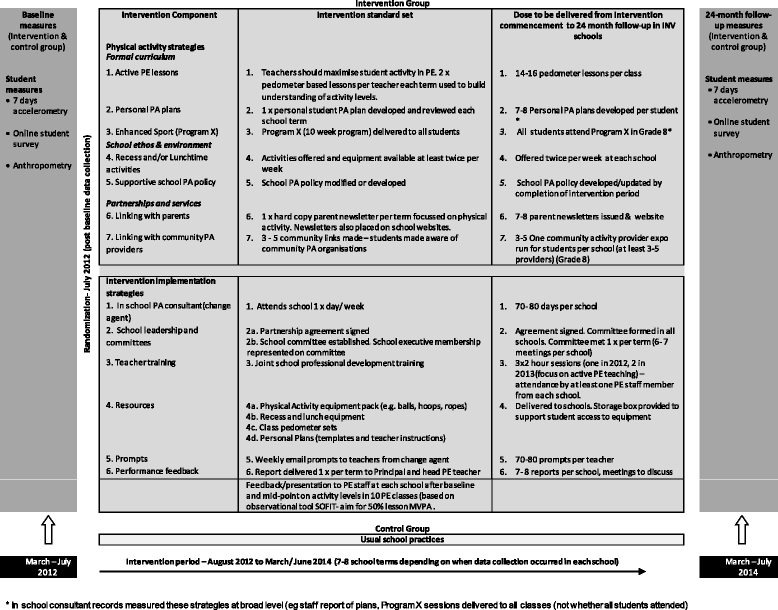Cost effectiveness of a multi-component school-based physical activity intervention targeting adolescents: the 'Physical Activity 4 Everyone' cluster randomized trial
- PMID: 27549382
- PMCID: PMC4994166
- DOI: 10.1186/s12966-016-0418-2
Cost effectiveness of a multi-component school-based physical activity intervention targeting adolescents: the 'Physical Activity 4 Everyone' cluster randomized trial
Abstract
Background: Few school-based interventions have been successful in reducing physical activity decline and preventing overweight and obesity in adolescent populations. As a result, few cost effectiveness analyses have been reported. The aim of this paper is to report the cost and cost effectiveness of the Physical Activity 4 Everyone (PA4E1) intervention which was a multi-component intervention implemented in secondary schools located in low-income communities. Cost effectiveness was assessed using both the physical activity and weight status trial outcomes.
Methods: Intervention and Study Design: The PA4E1 cluster randomised controlled trial was implemented in 10 Australian secondary schools (5 intervention: 5 control) and consisted of intervention schools receiving seven physical activity promotion strategies and six additional strategies that supported school implementation of the intervention components. Costs associated with physical activity strategies, and intervention implementation strategies within the five intervention schools were estimated and compared to the costs of usual physical activity practices of schools in the control group. The total cost of implementing the intervention was estimated from a societal perspective, based on the number of enrolled students in the target grade at the start of the intervention (Grade 7, n = 837). Economic Outcomes: The economic analysis outcomes were cost and incremental cost effectiveness ratios for the following: minutes of moderate-to-vigorous physical activity (MVPA) per day gained, MET hours gained per person/day; Body Mass Index (BMI) unit avoided; and 10% reduction in BMI z-score.
Results: The intervention cost AUD $329,952 over 24 months, or AUD$394 per student in the intervention group. This resulted in a cost effectiveness ratio of AUD$56 ($35-$147) per additional minute of MVPA, AUD$1 ($0.6-$2.7) per MET hour gained per person per day, AUD$1408 ($788-$6,570) per BMI unit avoided, and AUD$563 ($282-$3,942) per 10% reduction in BMI z-score.
Conclusion: PA4E1 is a cost effective intervention for increasing the physical activity levels and reducing unhealthy weight gain in adolescence, a period in which physical activity typically declines. Additional modelling could explore the potential economic impact of the intervention on morbidity and mortality.
Trial registration: Australian New Zealand Clinical Trials Registry ACTRN12612000382875.
Keywords: Adolescents; Physical activity; Randomized controlled trial, Low income, Disadvantaged, Cost effectiveness, Economic; School.
Figures
Similar articles
-
A cluster randomised trial of an intervention to increase the implementation of physical activity practices in secondary schools: study protocol for scaling up the Physical Activity 4 Everyone (PA4E1) program.BMC Public Health. 2019 Jul 4;19(1):883. doi: 10.1186/s12889-019-6965-0. BMC Public Health. 2019. PMID: 31272421 Free PMC article. Clinical Trial.
-
Scale-up of the Physical Activity 4 Everyone (PA4E1) intervention in secondary schools: 24-month implementation and cost outcomes from a cluster randomised controlled trial.Int J Behav Nutr Phys Act. 2021 Oct 23;18(1):137. doi: 10.1186/s12966-021-01206-8. Int J Behav Nutr Phys Act. 2021. PMID: 34688281 Free PMC article. Clinical Trial.
-
Effects of a 'school-based' physical activity intervention on adiposity in adolescents from economically disadvantaged communities: secondary outcomes of the 'Physical Activity 4 Everyone' RCT.Int J Obes (Lond). 2016 Oct;40(10):1486-1493. doi: 10.1038/ijo.2016.107. Epub 2016 Jun 10. Int J Obes (Lond). 2016. PMID: 27430652 Free PMC article. Clinical Trial.
-
A systematic review and meta-analysis of school-based interventions with health education to reduce body mass index in adolescents aged 10 to 19 years.Int J Behav Nutr Phys Act. 2021 Jan 4;18(1):1. doi: 10.1186/s12966-020-01065-9. Int J Behav Nutr Phys Act. 2021. PMID: 33397403 Free PMC article.
-
A systematic review and meta-analysis of the overall effects of school-based obesity prevention interventions and effect differences by intervention components.Int J Behav Nutr Phys Act. 2019 Oct 29;16(1):95. doi: 10.1186/s12966-019-0848-8. Int J Behav Nutr Phys Act. 2019. PMID: 31665040 Free PMC article.
Cited by
-
A cluster randomised trial of an intervention to increase the implementation of physical activity practices in secondary schools: study protocol for scaling up the Physical Activity 4 Everyone (PA4E1) program.BMC Public Health. 2019 Jul 4;19(1):883. doi: 10.1186/s12889-019-6965-0. BMC Public Health. 2019. PMID: 31272421 Free PMC article. Clinical Trial.
-
Results of a feasibility cluster randomised controlled trial of a peer-led school-based intervention to increase the physical activity of adolescent girls (PLAN-A).Int J Behav Nutr Phys Act. 2018 Jun 7;15(1):50. doi: 10.1186/s12966-018-0682-4. Int J Behav Nutr Phys Act. 2018. PMID: 29880048 Free PMC article. Clinical Trial.
-
Interventions to prevent obesity in children aged 12 to 18 years old.Cochrane Database Syst Rev. 2024 May 20;5(5):CD015330. doi: 10.1002/14651858.CD015330.pub2. Cochrane Database Syst Rev. 2024. PMID: 38763518 Free PMC article.
-
Economic evaluation of a childhood obesity prevention programme for children: Results from the WAVES cluster randomised controlled trial conducted in schools.PLoS One. 2019 Jul 10;14(7):e0219500. doi: 10.1371/journal.pone.0219500. eCollection 2019. PLoS One. 2019. PMID: 31291330 Free PMC article. Clinical Trial.
-
Long-term effects of adolescent obesity: time to act.Nat Rev Endocrinol. 2018 Mar;14(3):183-188. doi: 10.1038/nrendo.2017.147. Epub 2017 Nov 24. Nat Rev Endocrinol. 2018. PMID: 29170543 Review.
References
-
- Li L. The financial burden of physical inactivity. J Sport Health Sci. 2014;3(1):58–9. doi: 10.1016/j.jshs.2013.12.003. - DOI
Publication types
MeSH terms
Associated data
LinkOut - more resources
Full Text Sources
Other Literature Sources
Medical
Research Materials
Miscellaneous



